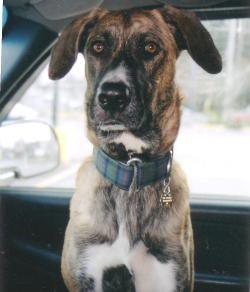

Shadrach is an 9-month-old Great Dane/German Shepherd mix. His owner rescued him from the local dog pound at the age of about three months, and he's grown into a good-tempered and playful dog. He is very active and athletic, and loves to chase balls and frisbees, which he does every day. Shadrach lives on a small farm, rides in the truck with the owner, leaping in and out of the vehicle as The Boss goes about his daily chores. He's been raised on a high-protein premium-grade dog food available at the local Mega-Pet Superstore and according to his owner, "He grew so fast when he was a puppy you could almost see him get bigger." Other than his lameness there's nothing unusual, he's a very healthy and outgoing dog who seems to love everybody.
Shadrach's owner comes to your clinic with a complaint that he's a little lame, "...been limping a bit for the past two weeks, especially after a play session." He reports that the limp goes away after a while so he hasn't been too worried; "I figured it was a pulled muscle or something." But the last bout of lameness lasted several days and he's decided to have it looked at.
You order radiographs and after viewing these films, put them together with his history to decide that Shadrach has osteochondrosis dissecans (OCD), a disease affecting the cartilage and articulating surfaces of bones; as is true of 75% of such cases, his is in the shoulder joint.
Points to ponder:
1. What cell type(s) is (are) involved in the development of OCD? What are the cellular events and processes that have been affected?
2. Why is it more likely to develop in joints and not in other regions of the body where cartilage is present in the adult?
3. The owner loves the dog and has good intentions: but can you think of anything he's done that might have exacerbated the development of this condition?